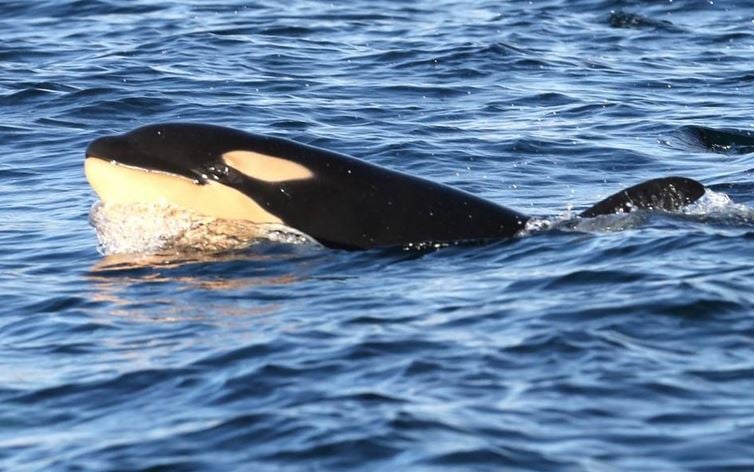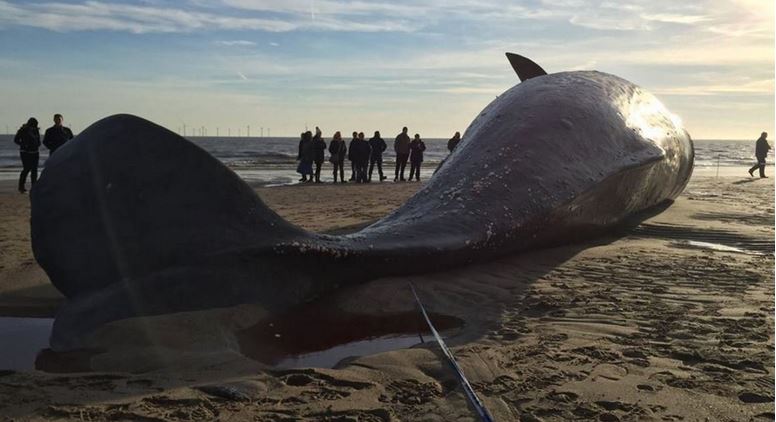Ship noise is harming whales, specifically killers whales (orcas), and is likely partly the cause of their deaths, says a team of scientists from the United States. Noises from nearby ships interfere with whales’ ability to pursue prey using their sense of hearing (echolocation).
When an endangered orca is chasing a fish, such as a salmon, it emits click sounds and listens for their echoes. This echolocation technique is crucial for them to be able to effectively chase and catch their prey.
Scott Veirs, from the Beam Reach Marine Science and Sustainability School in Seattle; Val Veirs, who works at Colorado College’s Department of Physics; and Jason Wood, from SMRU Consulting in Friday Harbor, Washington, set out to determine whether the noise from a shipping lane near Seattle was interfering with the killer whale’s ability to catch dinner.
 This photo of a baby orca in Haro Strait was taken in December 2015. It is the seventh baby born into the southern resident pod since December 2014. (Image: kuow.org. Credit: Mark Malleson/Pacific Whale Watch Association)
This photo of a baby orca in Haro Strait was taken in December 2015. It is the seventh baby born into the southern resident pod since December 2014. (Image: kuow.org. Credit: Mark Malleson/Pacific Whale Watch Association)
Largest ever shipping noise study
They measured underwater noise as the vessels passed their study site three thousand times. This largest ever collection of data regarding shipping noise will also help researchers investigating the potential effects on other marine life, as well as finding mitigating strategies, they said.
The scientists, who wrote about their study and findings in the open-access, peer-reviewed academic journal PeerJ, explained that researchers had already known that one of the threats faced by the world’s oceans today is underwater noise pollution from ships.
The growth in commercial shipping worldwide has increased the intensity of low-frequency noise by nearly tenfold over the past fifty years.
As this shipping noise occurs at the very low frequencies used by baleen whales – whales that have plates of whalebone in their mouths for straining plankton, such as rorquals, humpbacks, right whales, and grey whales – it may undermine their ability to communicate, and therefore their ability to survive.
Orcas use higher frequencies than baleen whales
In this study, the researchers wanted to determine whether the underwater ship noise might extend to the higher frequencies used by orcas and other toothed whales, and if so, whether their ability to survive is also affected.
To be able to answer this question and understand the nature of noise from ships, especially in areas along the coast where ships access ports, the team measured about 1,600 unique ships as they went through Haro Strait in Washington state.
 Orcas face several man-made problems. Even though PCBs (polychlorinated biphenyls) were banned in the 1980s, their lingering effects mean European killer whales and dolphins are facing extinction, scientists from the Zoological Society of London said. (Image: Zoological Society of London)
Orcas face several man-made problems. Even though PCBs (polychlorinated biphenyls) were banned in the 1980s, their lingering effects mean European killer whales and dolphins are facing extinction, scientists from the Zoological Society of London said. (Image: Zoological Society of London)
These waters form part of the core critical habitat for the endangered Southern Resident killer whales, which eat salmon and are iconic in the Pacific Northwest. If these whales vanished, the multi-million dollar ecotourism industry in Canada and the US would collapse.
Wider range of frequencies studied
Because these killer whales (orcas), like other toothed whales, use mid-and-high-frequencies to find food and communicate, the researchers measure a wide range of frequencies – from 10 Hz to 40,000 Hz.
They found that passing ships are responsible for the higher background levels not only of low-frequency sounds, as expected, but also at medium and higher frequencies. Orcas hear best at 20,000 Hz – the scientists found that ships were also producing lots of underwater noise at this frequency.
This means that in areas along and near the coast, where these giant marine mammals live within a few miles of shipping lanes, the noise emitted by ships could undermine their ability to communicate and find and catch food.
The authors say their study is unique because it estimates the source levels of larger populations and a greater range of classes of ships than in previous studies.
Military stealth favours whale survival
Container ships exhibited the highest median source levels – at all frequencies below 20,000 Hz. Some of the lowest noise levels were detected in military vessels – in times of war and military conflict, the quieter you are the harder it is for your enemy to detect or target you.
 Earlier this month, several dead sperm whales washed up on a beach near Skegness in Lincolnshire, England. Scientists are still trying to find out why. Could it be ship-noise related? (Image: Zoological Society of London Facebook)
Earlier this month, several dead sperm whales washed up on a beach near Skegness in Lincolnshire, England. Scientists are still trying to find out why. Could it be ship-noise related? (Image: Zoological Society of London Facebook)
The authors believe that if commercial vessels acquired the propulsion technology used by military ships, whales would be more likely to thrive.
Underwater noise pollution could also be reduced significantly if ships just slowed down when approaching coastal areas. The study data suggest that, on average, for every *knot a ship decelerates, its broadband noise levels decline by 1 decibel (dB).
* One knot equals 1.15 miles (one nautical mile).
Citation: “Ship noise extends to frequencies used for echolocation by endangered killer whales,” Scott Veirs, Jason D. Wood and Val Veirs. PeerJ 4:e1657. Published 2 February 2016. DOI: org/10.7717/peerj.1657. (Full article PDF)
BBC Earth Video – Killer Whales are Formidable Hunters
In this amazing clip, Sir David Attenborough talks us through the strategy killer whales use as they hunt down a grey whale calf. They first separate the calf from its mother, and then drown it.
